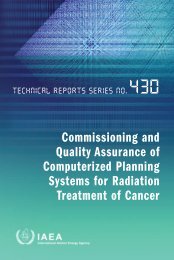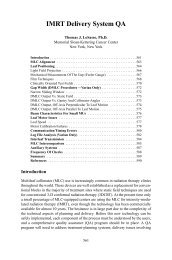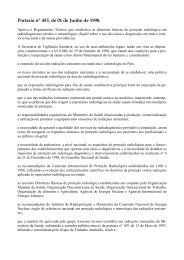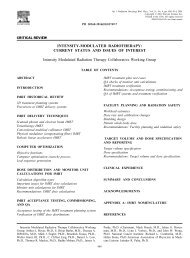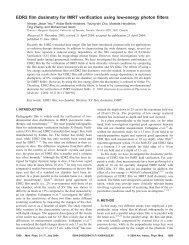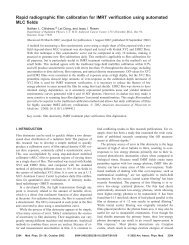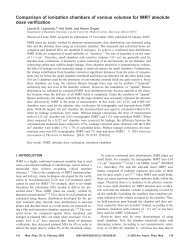Clinical evaluation of monitor unit software and the application of ...
Clinical evaluation of monitor unit software and the application of ...
Clinical evaluation of monitor unit software and the application of ...
Create successful ePaper yourself
Turn your PDF publications into a flip-book with our unique Google optimized e-Paper software.
<strong>of</strong> <strong>the</strong>se limitations are limited <strong>and</strong> practical guidelines for<br />
QA <strong>of</strong> TPS have become available only recently. From previous<br />
ESTRO projects on quality assurance (QA) aspects in<br />
radio<strong>the</strong>rapy that include <strong>the</strong> treatment planning system<br />
(e.g. ESTRO-EQUAL or QUASIMODO) it can be concluded that<br />
<strong>the</strong>re are uncertainties related to <strong>the</strong> dose calculation models<br />
[4,7,9]. Ano<strong>the</strong>r example is <strong>the</strong> study <strong>of</strong> Venselaar <strong>and</strong><br />
Welleweerd [21], where it is shown that especially asymmetric<br />
wedged beams are not properly modelled in some<br />
commercial treatment planning systems.<br />
On <strong>the</strong> o<strong>the</strong>r h<strong>and</strong>, it is generally accepted that deviations<br />
larger than 5% between delivered <strong>and</strong> prescribed doses<br />
may influence <strong>the</strong> clinical outcome <strong>of</strong> <strong>the</strong> treatment [2,14].<br />
For specific tumours <strong>and</strong> situations, such as in clinical trials,<br />
even higher dem<strong>and</strong>s might be required in terms <strong>of</strong> dosimetric<br />
accuracy. Because errors <strong>and</strong> large uncertainties in dose<br />
calculations reduce <strong>the</strong> quality <strong>of</strong> a treatment, independent<br />
dose or MU calculations have been recommended <strong>and</strong> also<br />
used for a long time as a routine quality assurance (QA) procedure<br />
when verifying individual treatment plans<br />
[3,11,15,16]. During <strong>the</strong> last years commercial products<br />
providing independent dose calculations that can h<strong>and</strong>le<br />
all advanced treatment techniques have become available.<br />
However, to our knowledge no reports have been published<br />
that describes <strong>the</strong>ir accuracy or o<strong>the</strong>r aspects <strong>of</strong> <strong>the</strong>ir clinical<br />
<strong>application</strong>.<br />
Verification calculations are traditionally performed by<br />
applying empirical algorithms in a manual calculation procedure,<br />
or utilizing s<strong>of</strong>tware based on fairly simple dose calculation<br />
algorithms. With <strong>the</strong> advent <strong>of</strong> advanced treatment<br />
techniques that are based on <strong>the</strong> availability <strong>of</strong> multileaf<br />
collimators, asymmetric jaws <strong>and</strong> dynamic or virtual<br />
wedges, empirical dose calculation procedures become<br />
much more complex <strong>and</strong> <strong>the</strong>ir accuracy is <strong>of</strong>ten limited by<br />
<strong>the</strong> simplicity <strong>of</strong> <strong>the</strong> model itself [6]. To achieve high accuracy<br />
with an independent dose calculation tool also for <strong>the</strong><br />
most complex treatment techniques, more sophisticated<br />
models are required [12,13,22]. On <strong>the</strong> o<strong>the</strong>r h<strong>and</strong>, only<br />
models that allow detailed investigations <strong>of</strong> <strong>the</strong> dosimetric<br />
accuracy, <strong>and</strong> consequently enable more strict action levels<br />
(AL), will be effective in catching systematic uncertainties<br />
<strong>of</strong> <strong>the</strong> TPS. Moreover, misinterpretations <strong>of</strong> TPS results,<br />
<strong>and</strong> <strong>the</strong> occurrence <strong>of</strong> errors associated with <strong>the</strong> limited<br />
accuracy <strong>of</strong> empirical verification models can be greatly<br />
reduced.<br />
As a general requirement, an ideal verification dose calculation<br />
model should be as independent as possible <strong>of</strong> <strong>the</strong><br />
TPS, <strong>and</strong> should be based on physical effects which are<br />
accurately described <strong>and</strong> tuned by an independent set <strong>of</strong><br />
algorithm input data [10]. Additionally, <strong>the</strong> verification<br />
s<strong>of</strong>tware implementation should provide high accuracy<br />
uncorrelated to <strong>the</strong> radio<strong>the</strong>rapy equipment in use, i.e. its<br />
accuracy should nei<strong>the</strong>r depend on <strong>the</strong> type <strong>of</strong> linear accelerator<br />
nor <strong>the</strong> photon beam energy for which it has been<br />
commissioned. To be able to verify multiple beams in an<br />
efficient way, it should manage to import treatment plan<br />
data (e.g. MLC settings) directly from <strong>the</strong> TPS or <strong>the</strong> record<br />
<strong>and</strong> verify (R&V) system.<br />
Ideally, a full QA-procedure should include verification <strong>of</strong><br />
all parameters including <strong>the</strong> patient anatomy <strong>and</strong> positioning.<br />
In <strong>the</strong> procedure suggested here <strong>the</strong> patient geometry<br />
D. Georg et al. / Radio<strong>the</strong>rapy <strong>and</strong> Oncology 85 (2007) 306–315 307<br />
is verified separately on an everyday basis. The MU verification<br />
tool will thus be used only prior to <strong>the</strong> treatment start,<br />
provided that <strong>the</strong> integrity <strong>of</strong> <strong>the</strong> database can be secured<br />
by o<strong>the</strong>r methods during <strong>the</strong> duration <strong>of</strong> <strong>the</strong> treatment<br />
period.<br />
The overall intention in modern radiation <strong>the</strong>rapy is to<br />
keep <strong>the</strong> dose delivered to <strong>the</strong> patient as close as possible<br />
to <strong>the</strong> prescribed dose, i.e. to fulfil a tight dosimetric tolerance<br />
level. Such a dosimetric tolerance level should be<br />
based on clinical considerations related to radiobiological<br />
parameters. In order to secure that a treatment falls within<br />
this dosimetric tolerance level at a given probability an action<br />
level must be derived. This action level will <strong>the</strong>n also<br />
be dependent on <strong>the</strong> accuracy <strong>of</strong> <strong>the</strong> verification tool.<br />
Hence, for a given dosimetric tolerance level <strong>and</strong> a known<br />
uncertainty in <strong>the</strong> verification, <strong>the</strong> action level that should<br />
be applied for that individual treatment plan can be estimated.<br />
Correctly applied, this concept will always result<br />
in an action level that is narrower than <strong>the</strong> dosimetric tolerance<br />
level. An MU s<strong>of</strong>tware should <strong>the</strong>refore be designed to<br />
give a high degree <strong>of</strong> accuracy, including an estimation <strong>of</strong><br />
<strong>the</strong> overall uncertainty in <strong>the</strong> dose calculation.<br />
The aim <strong>of</strong> <strong>the</strong> present work was to test <strong>and</strong> evaluate a<br />
fluence-based independent dose calculation (or MU) algorithm<br />
(for point dose calculations) against calculations from<br />
various commercial 3D treatment planning systems under<br />
clinical conditions. For that purpose clinically accepted<br />
<strong>and</strong> approved treatment plans were considered. For a subgroup,<br />
deviations were fur<strong>the</strong>r analysed by measurements.<br />
The clinical <strong>application</strong>s covered open beams, wedged<br />
beams with both physical <strong>and</strong> dynamic wedges, <strong>and</strong> step<strong>and</strong>-shoot<br />
as well as dynamic IMRT. The underlying model<br />
for independent calculations was implemented in such a<br />
way that only a few input data are needed for commissioning<br />
<strong>and</strong> tuning; thus <strong>the</strong> workload for basic algorithm input<br />
data acquisition <strong>and</strong> commissioning is reduced to a minimum.<br />
Fur<strong>the</strong>rmore, <strong>the</strong> risk for commissioning errors is largely<br />
reduced with a minimum number <strong>of</strong> input data. By<br />
analysing <strong>the</strong> resulting deviations between dose calculations<br />
performed with a TPS <strong>and</strong> MUV we have tried to assess <strong>the</strong><br />
<strong>application</strong> <strong>of</strong> action levels for independent dose checks<br />
for advanced conformal radio<strong>the</strong>rapy.<br />
Methods <strong>and</strong> materials<br />
Independent dose calculation s<strong>of</strong>tware MUV<br />
The semi-analytical model implemented in <strong>the</strong> s<strong>of</strong>tware<br />
MUV, which st<strong>and</strong>s for <strong>monitor</strong> <strong>unit</strong> verification, was based<br />
on a two step procedure: (i) calculation <strong>of</strong> <strong>the</strong> energy fluence<br />
per <strong>monitor</strong> <strong>unit</strong> exiting <strong>the</strong> treatment head, <strong>and</strong> (ii)<br />
calculation <strong>of</strong> <strong>the</strong> dose deposition in <strong>the</strong> phantom resulting<br />
from <strong>the</strong> incident energy fluence. The energy fluence part<br />
in <strong>the</strong> dose calculation takes into account <strong>the</strong> direct energy<br />
fluence, scattered radiation from an extra-focal source <strong>and</strong><br />
scattered fluence from secondary collimators, as well as<br />
backscattered radiation to <strong>the</strong> <strong>monitor</strong> chamber [19,20].<br />
The dose deposition was based on a pencil beam model, with<br />
a radial parameterisation [1,17,18]. For dose calculations,<br />
collimator transmission <strong>and</strong> <strong>the</strong> effect <strong>of</strong> rounded leaf ends



